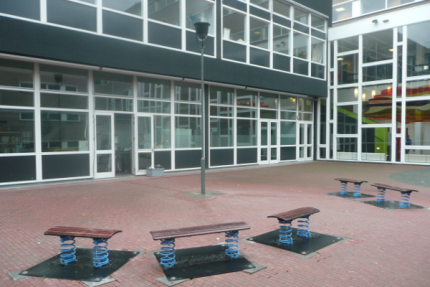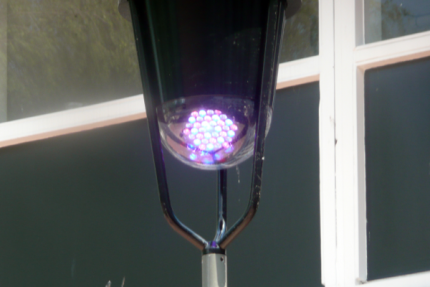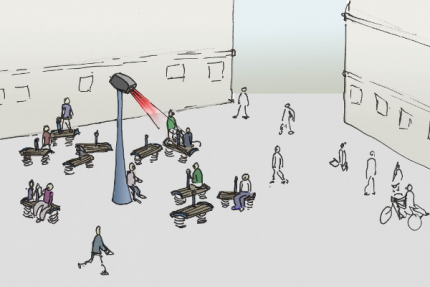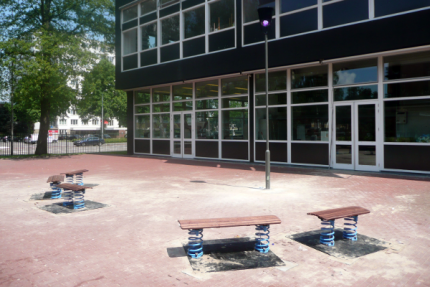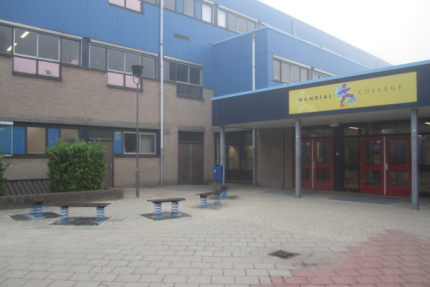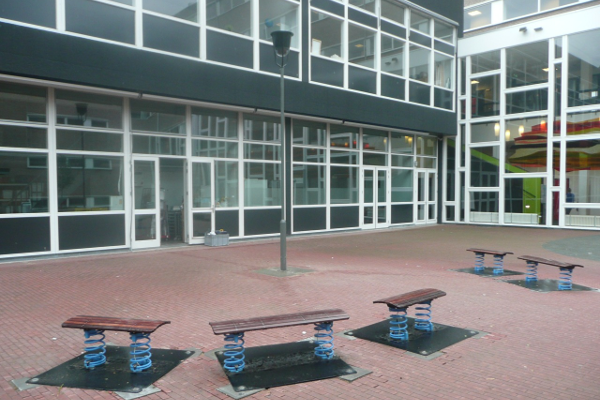Wiggle the Eye
by Tieben and colleagues
Interactive seats and a streetlight that elicit physical and social play.
Design study during PlayFit project by Rob Tieben, Pepijn Rijnbout and Linda de Valk.
PROJECT DESCRIPTION
Wiggle the Eye is a playful installation that elicits physical and social play. By sitting and wiggling on one of the interactive seats, players control the central streetlight and the vibration motors in other seats. This novel outcome stimulates players to be physically active while sitting, in order to discover what is possible with the installation. The installation is public, so one’s actions influence the experience of other players, resulting in strong social interaction.
Wiggle the Eye has been evaluated with more than 500 users at events, high schools and other public spaces. Teenagers were motivated to start playing in an (inherently) active way, while enjoying themselves in a creative and social way. Creativity, pleasure and social interaction were enhanced while sedentary activity was reduced – a good solution to fight the inactivity problem while providing a creative and autonomous moment.
This installation was designed and developed by Linda de Valk, Pepijn Rijnbout and Rob Tieben, as part of the PlayFit project and the CRISP I-PE project.
SCENARIO
The schoolyard of a highschool in Eindhoven: five new benches, and a streetlight with a mysterious globe. During lunchbreak, hesitant teenagers take place on the benches, and discover that they can wiggle and balance with their peers. The globe appears to contain a moving light: when it is looking towards a bench, the bench suddenly starts to vibrate – to the hilarity of the teens.
Designer’s pitch
Our goal for Wiggle the Eye was to design an installation that we could use for long-term evaluations, to see if we could elicit playful interaction over longer periods of time. For this, we required a high-fidelity prototype with programmable interaction possibilities. Designing interactive seats for an outside schoolyard introduced a whole range of safety and feasibility issues. We closely cooperated with an engineering development firm to ensure high quality results. The benches consisted of standard playground equipment springs with a custom-made seating element. In the seat, we installed an altered DC-motor to create vibrations, and custom electronics for the sensing and control.The benches were installed in cooperation with a street construction company; this again required several trials to find a robust and safe placement solution for the schoolyard.In general, the development and installation of this high fidelity prototype required a relative high amount of investment and work before we could evaluate our first play scenario. This investment is required and worth it for long-term evaluations, but does require a different approach than ‘regular’ design research. Many lessons were learned for future similar projects, on a university, design and research level.
Observer’s pitch
In the evaluation of Wiggle the Eye, we were especially interested in the free play and exploration process, and in the changes in playful interaction over time. For this, we had to observe the playful interactions and had to speak with the teenagers, without disrupting their exploration process.The combination of diaries, interviews and observations provided us with a myriad of insights and interactions with teenagers. Once again, our presence in the school became apparent within hours, resulting in many curious teenagers that questioned us about the installation: “is it a camera to detect if we are smoking? does it turn blue when the sun is visible?”. The informal interaction allowed us to listen to the experiences of the students; we complemented this with analysis data about the observations and diaries. Through triangulation, we managed to develop a good qualitative understanding of the playful behaviour with Wiggle the Eye.
